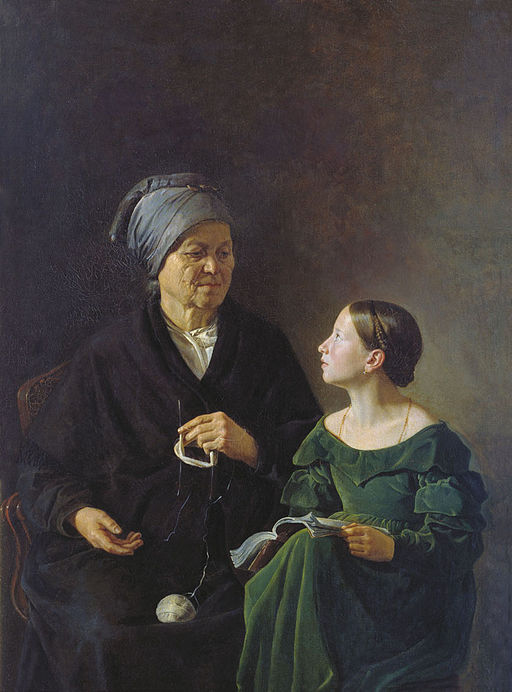By Georgia Mierswa
Oxford University Press would like to take a moment to honor all grandparents, great-grandparents, and beyond, acknowledging the often extraordinary efforts (more are primary caregivers than ever before in history!) required to build and sustain a family. The information and statistics below have been drawn from numerous articles on the significance of grandparents in the Encyclopedia of Social Work online.
At the turn of the 20th century, only 6% of 10-year-olds had all four grandparents alive, compared with 41% in 2000 (Bengtson, Putney, & Wakeman, 2004). Accordingly, more adults are grandparents and, increasingly, great-grandparents, although they have proportionately fewer grandchildren than preceding generations.

Leo Tolstoy (1828-1910) with his granddaughter in Yasnaya Polyana.
Public domain via Wikimedia Commons.
Among parents aged 90 and older, 90% are grandparents and nearly 50% are great-grandparents, with some women experiencing grandmotherhood for more than 40 years. This is because the transition to grandparenthood typically occurs in middle age, not old age, with about 50% of all grandparents younger than 60 years. As a result, there is wide diversity among grandparents, who vary in age from their late 30s to over 100 years old, with grandchildren ranging from newborns to retirees.

Queen Henriette Marie with her daughter, granddaughter and son in law from the Family of Louis XIV. Painting by Jean Nocret (1615-1672).
Public domain via Wikimedia Commons.
While managing conditions related to their own aging process, many older adults assume caregiving responsibilities. In fact, about half of all individuals aged 55–64 spend an average of 580 hours per year caring for family members (Johnson & Schaner, 2005a).

Großmutter mit drei Enkelkindern, signiert Waldmüller – Ferdinand Georg Waldmüller (1793-1835).
Public domain via Wikimedia Commons.
Grandparents may have primary responsibility for raising grandchildren. About 2.5 million grandparents have responsibility for raising one or more grandchildren within the same household (U.S. Census Bureau, 2009). Additionally, over 40% of grandparents in a custodial role are over 60 years of age (U.S. Census Bureau, 2010).

“The First Steps”. Georgios Jakobides (1853-1932).
Public Domain via Wikimedia Commons.
Most grandparents derive satisfaction from their role and interaction with grandchildren (Reitzes & Mutran, 2004; Uhlenberg, 2004).
The Naughty Grandson by Georgios Jakobides (1853-1932).
Public domain via Wikimedia Commons
With over 2.4 million custodial grandparents providing primary care, skipped-generation households—the absence of the parent generation—are currently the fastest growing type. Among the challenges are reductions in free time, limitations on housing options, increased demands on resources, and even situations where the retiree needs to return to work to support this new family situation.

Old food seller and his granddaughter Varanasi Benares India.
Photo by Jorge Royan. Creative Commons License. via Wikimedia Commons.
Grandparent caregivers have been called the “silent saviors” of the family.

Mohov Mihail (1819-1903). Grandmother and granddaughter.
Public domain via Wikipedia Commons.
As a result of longer life expectancy, many of today’s families are multigenerational. Parents and children now share five or six decades of life, siblings may share eight or nine decades of life, and the grandparent–grandchild bond may last three or four decades.
As Bengston notes, longer years of shared living may offer a multigenerational kinship network to provide family continuity and stability across time as well as instrumental and emotional support in times of need.

Franklin D. Roosevelt, Delano grandparents, uncles, and cousins in Newburgh, New York. Photo provided by Franklin D. Roosevelt Library (NLFDR), National Archives and Records Administration. Public domain via Wikimedia Commons
Georgia Mierswa is a marketing associate at Oxford University Press. She began working at OUP in September 2011.
The Encyclopedia of Social Work is the first continuously updated online collaboration between the National Association of Social Workers (NASW Press) and Oxford University Press (OUP). Building off the classic reference work, a valuable tool for social workers for over 85 years, the online resource of the same name offers the reliability of print with the accessibility of a digital platform. Over 400 overview articles, on key topics ranging from international issues to ethical standards, offer students, scholars, and practitioners a trusted foundation for a lifetime of work and research, with new articles and revisions to existing articles added regularly.
Subscribe to the OUPblog via email or RSS.
Subscribe to only social work articles on the OUPblog via email or RSS.



Recent Comments
There are currently no comments.